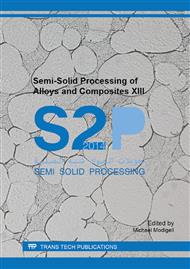p.201
p.208
p.219
p.227
p.235
p.241
p.247
p.253
p.259
Unconventional Microstructures in Tool Steel Obtained by Semi-Solid Processing and Subsequent Heat Treatment
Abstract:
Mechanical properties of all metals depend predominantly on the type and morphology of their microstructure. Microstructure attributes can be altered by various heat treating and thermomechanical treatment procedures. One of the advanced techniques profoundly affecting the microstructure evolution is semi-solid processing. It can produce unconventional microstructures even in conventional steel types. Moreover, subsequent heat treatment can also deliver a wide range of microstructures and correspondingly varied mechanical properties. In the present experimental programme, the X210Cr12 ledeburitic tool steel was studied. Its initial annealed microstructure consisted of ferritic matrix, chromium carbides and globular cementite particles. The semi-solid processed structure, on the other hand, contained polyhedral austenite grains embedded in carbide-austenite network. The austenite volume fraction exceeded 95 %. This microstructure was then altered by subsequent heat treatment or thermomechanical treatment. The experimental programme comprised three stages. At the first stage, the effects of the rate of cooling from the semi-solid region to the ambient temperature on the nature and morphology of the ledeburitic network and the austenitic grain size were explored. The second stage was aimed at the impact of tensile and compressive deformation applied after transition through semi-solid state on the microstructure evolution and, in particular, on grain size. Once suitable processing conditions and parameters were identified, the treatment led to a recrystallized austenitic microstructure with an average grain size of less than 3 μm. As high volume fractions of austenite were obtained, the third stage involved exploring the effects of thermal exposure. The stability of austenite and the decomposition of austenite into other microstructure constituents were mapped. Metallographic observation revealed a resulting wide range of microstructures from fine pearlite to martensite, depending on the heat treating schedule.
Info:
Periodical:
Pages:
235-240
Citation:
Online since:
September 2014
Authors:
Permissions:
Share:
Citation:


